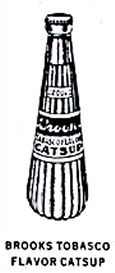
Thursday, October 7, 2004
Page 15
REMINISCING (Column)
Tomato and Tabasco: a Perfect Pairing
By ROGER M. GRACE
Tomato products and Tabasco Sauce go together like cheese and crackers.
There’s no cocktail sauce on the market that’s an improvement on simply pouring ketchup in a bowl, plopping in some horseradish, and adding dashes of Tabasco Sauce.
And ketchup, to many, is always enhanced by the addition of Tabasco Sauce, especially in light of all the sweetner that’s added to ketchup these days to cater to the tastes of children.
In 1991, the makers of Tabasco Sauce began marketing, on a limited basis, McIlhenny Farms Spicy Ketchup—that is, ketchup perked up with the company’s red-hot condiment. I’ve never seen it for sale locally, and it appears still not to be in wide distribution. It is, however, available from McIlhenny over the Internet.
On a wider basis, Heinz in 1994 started selling a ketchup with Tabasco Sauce added, a product to which the relatively new term “co-branding” was applied. That was a forerunner of a product now on the market. On Jan. 22, 2002, Heinz launched three varieties of “Ketchup Kick’rs,” the “hot and spicy” member of the trio being made, under license, with Tabasco Sauce.
Ironically, Heinz was one of those supposed infringers that caused the gnashing of teeth of members the McIlhenny clan in the 1890s based on the use of the term “tabasco,” to which the McIlhenny’s have long claimed exclusive right. Dave DeWitt and Chuck Evans, in their 1996 book, “The Hot Sauce Bible,” noted that “sometime shortly after 1889, Heinz produced Heinz’s Tabasco Pepper Sauce in a elegant bottle; but alas, even Heinz couldn’t compete with the ‘real’ Tabasco sauce.”
Others, too, made Tabasco ketchup.
Among them was an outfit known for its canned soups, the Joseph Campbell Company, headquartered in Philadelphia. In 1911, it introduced Campbell’s Tabasco Ketchup, ascribing to it “the appetizing piquancy of Tabasco Sauce in milder form.”
In 1916, the Gibbs Preserving Company Corporation of Baltimore, Maryland was granted registration of a trademark on “Bull Head,” a brand name it had used since 1883. Among the products to which the name applied was “tomato catsup with tabasco sauce.”
There was a regional version put out by Brooks Tomato Products Co. of Collinsville, Ill. Here’s a depiction of a bottle from a 1916 newspaper ad:
|
|
In the mid-1940s, the McIlhenny Company threated suit for infringement against the G.S. Suppiger Company of St. Louis, which then owned the Brooks line. To avoid litigation costs, Suppiger changed the name of “Brooks Tabasco Flavor Catsup” to “Brooks Old Original Tangy Catsup.” (Re-dubbed “Brooks Rich & Tangy Ketchup,” it’s now manufactured by Birds Eye, and marketed primarily in the mid-west.)
P.J. Ritter Company of Philadelphia also manufactured a Tabasco ketchup in the mid-1940s. That company merged with Suppiger in 1959.
Tomato juice and Tabasco Sauce are, of course, combined in the Bloody Mary, made with vodka and other ingredients, as well as the boozeless Virgin Mary, and the worthy variations on the Bloody Mary, the Bloody Bull (with beef boullion) and the Bloody Caeser (with clam juice).
The Bloody Mary is believed to have been invented in 1921 by Fernand Petiot at Harry’s New York Bar in Paris. Petiot later recited that “one of the boys suggested we call the drink ‘Bloody Mary’ because it reminded him of the Bucket of Blood Club in Chicago, and a girl there named Mary.”
It did not include Tabasco Sauce; rather, it was half tomato juice, the other half vodka. After he took a job in 1934 at the King Cole Bar at the St. Regis Hotel in New York, Petiot found that his drink was too bland for American tastes — and so, he added Tabasco Sauce to it (as well as Worcestershire Sauce, black pepper, cayenne pepper, and lemon).
The origin of the Bloody Bull is uncertain. It’s related to the Bullshot, which lacks tomato juice. What’s no bull is that neither concoction is at its best without Campbell’s beef boullion (which is condensed, hence hearty).
The Bloody Caesar originated in Canada in 1969, the creation of bartender Walter Salin Chell. The drink is most commonly made with Mott’s Clamato Tomato Cocktail, a product owned by the British company that makes Schweppes tonic water. The “cocktail” combines tomato juice, clam extrative, and other ingredients.
Copyright 2004, Metropolitan News Company
CLICK
HERE for the next column on Tabasco Sauce
MetNews Main Page Reminiscing Columns